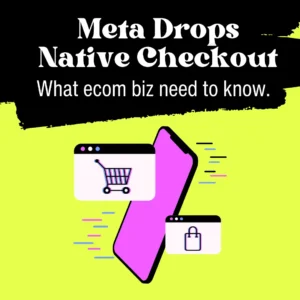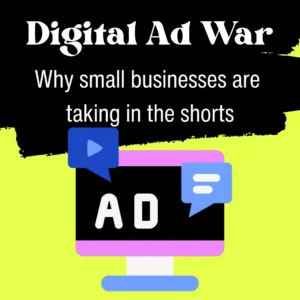In This Article
Feeling frustrated with your website, leads and marketing? Hit the easy button with an ACE Digital solution.
What’s Changing with Meta’s Checkout Strategy
Meta has officially begun phasing out native checkout on Facebook and Instagram Shops. PPC Land+3LinkedIn+3Feedonomics+3 Starting June 2025, merchants using in-app checkout will be transitioned to external checkout flows. Facebook+3Feedonomics+3Value Added Resource+3 By August, the native checkout experience should be deprecated for most U.S. merchants. Facebook+3Feedonomics+3PPC Land+3
Meta confirms that customers will still discover products in Shops, collections, and storefronts—but checkout, order processing, dispute resolution, and post-purchase handling must shift back to your own systems. Facebook+3Facebook+3Value Added Resource+3
Why Meta Is Pulling Back
- Operational complexity and cost: Managing payments, fulfillment, returns, and disputes at scale is expensive and complex. Meta may be seeking to reduce that burden. Value Added Resource+2GoDataFeed+2
- Control and data ownership: The in-app model limited merchant access to key data and control. Shifting checkout back to merchant sites returns that ownership. Value Added Resource+3GoDataFeed+3PPC Land+3
- Regulatory and antitrust pressure: In some markets, tightly integrated commerce may draw scrutiny. Pulling back could ease regulatory risk. Value Added Resource+1
- Low adoption and performance tradeoffs: Some merchants never fully adopted or optimized in-app checkout due to complexity, poor UX, or data limits. Feedonomics+2Value Added Resource+2
What Changes for Your Marketing, Ads & Funnels
Ad Conversion Tracking Will Shift
With native checkout gone, the “Conversion Location” setting will be retired. Meta will force ads to send people to your website for purchase. Feedonomics+2Value Added Resource+2
They are eliminating intermediate conversion events like Add to Cart and Initiate Checkout in favor of only the Purchase event in the new model. Feedonomics+2Value Added Resource+2
Historical in-app metrics will become deprecated and eventually unavailable. Feedonomics+2Value Added Resource+2
Order Management & Post-Purchase Tools Go Away
Commerce Manager will no longer support native order status, bulk actions, returns, or dispute resolution. Those responsibilities return to your back-end systems. Value Added Resource+2Facebook+2
Meta will archive historical data (balances, payout history) but no new transactions will be processed via its system. Value Added Resource+1
Impact by Platform
For Shopify merchants, the transition may temporarily lose order attribution during migration. PPC Land+3Shopifreaks+3Value Added Resource+3
For BigCommerce and other platforms, Meta is already prompting merchants to set “checkout URLs” to maintain functionality. BigCommerce
What You Should Do Right Now (Execution Priorities)
1. Audit Your Tech Stack & Data Flow
Ensure your site and backend can handle increased checkout volume, traffic spikes, and margin pressure. Run a full audit: site speed, payment gateway, mobile checkout UX, inventory systems.
Double-check your product feed: all SKUs must point to valid, variant-specific landing pages—not generic listings.
2. Update Meta Settings & Feeds Today
In Commerce Manager, configure your checkout URL (web checkout) for your shop. BigCommerce+2Facebook+2
Switch all ads to “Website” only conversion location. Remove reliance on in-app events.
Retag UTM parameters so post-click attribution stays intact. Consider revising feed logic to strip deprecated fields.
3. Reinforce Your Funnel & Retargeting Strategy
Because checkout happens off-platform, your funnel matters more than ever.
Use retargeting aggressively: those who click product tags but don’t convert are your highest-priority audience.
Ensure your email nurture and abandon-cart flows are fully optimized. Leverage behavioral triggers (site visits, exit intent) and sequence logic you already own.
4. Test & Iterate Weekly
This isn’t a one-off migration. Monitor conversion rates, bounce rates, attribution loss, funnel drop-offs. Adjust landing pages, UI elements, ad creative.
Treat Week 1–4 as a performance sprint: measure what feeds, pages, and offers hold under new load.
When This Change Favors You (if you execute cleanly)
- You regain full control over post-click UX, upsells, email capture, and data ownership.
- Ad spend becomes more efficient since off-platform conversion gives you access to deeper analytics.
- As Meta focuses on discovery and ads, the platform may favor Shops that drive real website conversions.
Internal View: Don’t Panic, Pivot Strategically
This shift by Meta doesn’t mean social commerce is dead—it means social commerce evolves. Smart founders will lean harder into control, performance, and the ability to own their own customer experience.
We always say: strategy before tactics. Platform changes will come and go—but a strong funnel, technical foundation, and conversion mindset are non-negotiable.
Hot Take
Meta dropping native checkout is less a failure and more a recalibration. It’s a confession that platform-controlled commerce struggled at scale. Smart brands will treat this as an opportunity: move decisively, reclaim control, and build resilience by owning the checkout journey again.
Golden Nugget
Begin right now by switching your ads to website conversion only, audit your feed landing URLs, and strengthen your retargeting and drop-off recovery flows. The companies that act fastest will turn disruption into advantage.





